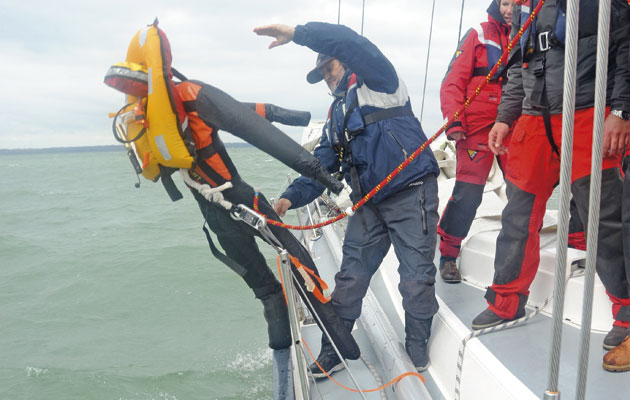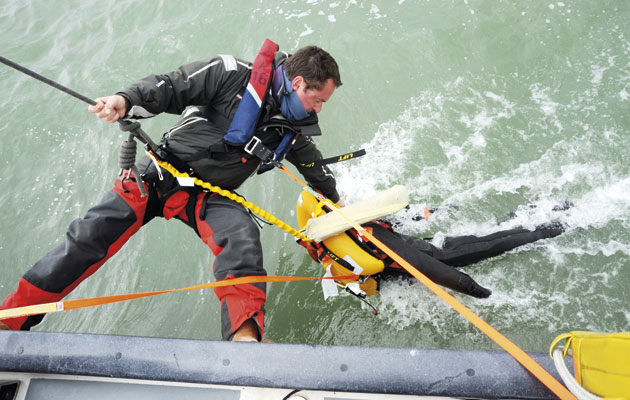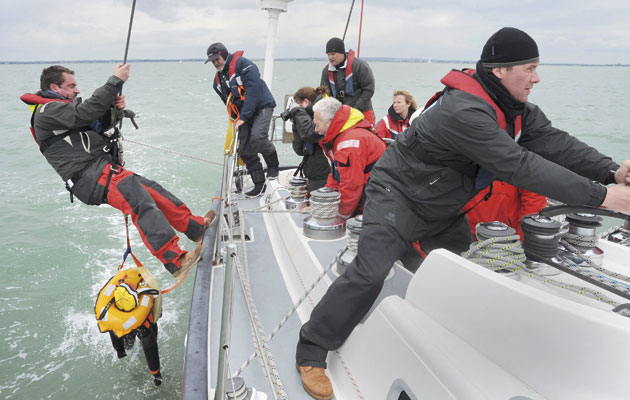Following an MOB fatality at sea, Sir Robin Knox-Johnston tests livesaving MOB recovery procedures at sea with the MAIB, the RYA and Yachting Monthly onboard. Dick Durham reports
MOB lifesaving lessons learned at sea
In 2011, a skipper drowned at the end of his harness tether having slipped overboard. The official report into his death by the Marine Accident Investigation Branch (MAIB) concludes most sailors wouldn’t have known how to save his life.
The ill-fated Lion, a 38ft Reflex sloop, was slashing through the night, one reef pulled down, overtaking rival yachts at the start of a 95-mile Royal Ocean Racing Club race from Cowes to Cherbourg. For skipper-owner Christopher Reddish, 47, from Clapham Junction, and his son, who was bowman, it was a qualifier for the Fastnet Race.
With a westerly wind gusting up to 38 knots and a rough, 3.5m sea running, Lion was making 9 knots over the ground and heeled at 20° to port. Just under two hours southwest of the Owers light, the helmsman sensed that the yacht’s handling characteristics had changed. That’s when he noticed they were trawling the No.1 genoa, which had been dropped and stowed on deck, with sail ties and bungy lines lashing it to the guardrail.
Mr Reddish went forward with one of his seven crew to retrieve it. Both were using harnesses, clipped on with tethers. As the sail was passed back to be lowered down the companionway, it snagged on a foredeck cleat. Mr Reddish lay on his stomach to free it. ‘OK,’ he shouted as the sail was freed. It was the last word he ever uttered.
A few minutes later, two crewmen saw a white lifejacket strobe light and the shout ‘Man overboard!’ went out.
Mr Reddish was being towed at 9 knots through rough seas by his 1.8m-long tether, pinned against the leeward side of the boat. The helmsman immediately slackened the mainsheet and the headsail sheets were eased a little later, which slowed the boat to 1.5 knots through the water.
It took the crew 16 minutes to recover the skipper to deck, where he was pronounced dead by a consultant cardiologist who was one of the crew.
A report into the fatality by the Marine Accident Investigation Branch (MAIB) found:
Prevailing conditions made the recovery physically challenging.
- No one had been nominated to replace the skipper if he was incapacitated. This hindered communications
- Recovery of a tethered man overboard (MOB) is not routinely covered in RYA training courses
The MAIB has also noted that sailing schools do not routinely carry out MOB tests with dummies to simulate the difficulties of dealing with an unconscious casualty, and that there are no ISO or EN standards for ensuring the ISAF recommendations that crotch and thigh straps on lifejackets should be strong enough to lift a person from the water.
After reading the report, Sir Robin Knox-Johnston invited MAIB investigator Roger Brydges, RYA training manager Richard Falk and Yachting Monthly aboard one of his Clipper 60 cutters, Black Adder, for a test of MOB recovery procedures in the Solent.
As we left Gosport, Sir Robin recalled two personal experiences of MOBs. One was aboard Suhaili, the 32ft wooden ketch he sailed non-stop and singlehanded around the world in 1967-68: on the delivery trip from Bombay to the UK, he lost and recovered a crewman overboard. The second was during the 1977 Whitbread Round the World Race: Heath’s Condor turned back and recovered a crewman whose position was marked only by circling albatrosses. During his years running the Clipper Round the World Race, a further three crewmen have gone overboard. In all five cases, the MOB was recovered successfully.
Under the careful command of skipper Jim Dobie, Black Adder sailed up and downwind across the Solent in blustery conditions, under full mainsail, staysail and yankee. She already had webbing jackstays running fore and aft along each sidedeck and we rigged an extra jackstay on the centreline of the foredeck. For the MOB tests, we used a 2m tether and a 40kg Ruth Lee rescue dummy, which, once immersed, weighed 65kg.
You can buy a wide range of patented MOB recovery devices, from slings to parbuckles, but for this test we assumed we were at sea without any special kit.
9 key findings from the test
- What happens when someone falls off the foredeck?
The dummy was heaved overboard from the foredeck while the boat was sailing at around 4 knots through the water. The tether held the dummy’s head face down, into the boat’s oncoming bow wave. Water would be funnelled directly down the throat, drowning the casualty in a few minutes.
Conclusion: The skipper must not be complacent that the MOB is attached to the boat. The boat must be stopped the instant a crewman goes overboard and his head hauled above the surface immediately.
- Could you be injured by the yacht’s hull?
At slower speeds, the dummy was found to float face up, but being towed through the water – even at a slower rate – its head being dashed against the side of the boat.
Conclusion: Crew must be on hand to haul the casualty’s head clear of the topsides while full recovery to the deck is organised.
- Should you heave-to?
When the dummy went overboard on the leeward side, we found that heaving the boat to, by tacking round immediately, lifted the MOB dummy clear of the water by hauling it up on the weather side.
Conclusion: Dumping the mainsail and headsail might not necessarily be the best option to stop the boat.
- What if someone falls out of the cockpit?
When the dummy went overboard from the cockpit while the boat was sailing downwind, it was dragged through the boat’s wake, which would soon have caused drowning in a real-life situation.
Conclusion: Crew should endeavour to heave the MOB clear of the stern, into flatter water amidships.
- What’s the best length for a harness tether?
All boats should carry tethers in several different lengths: long ones to enable crew to manoeuvre around the deck, shorter ones to clip on at the helm or while reefing at the mast or changing headsails. A centreline jackstay can improve safety on some boats, but make sure it is set to one side of the forehatch.
Conclusion: Clip on to the weather-side jackstay when you’re working on the bow. If you do get thrown, you only want your legs to go overboard – not your whole body.
- How hard is it to get an MOB back on deck?
At least two crew were required to retrieve the MOB dummy and hold it against the toerail. Hauling it up and over the guardrails demanded even more manpower and could not be achieved sailing shorthanded.
Conclusion: There must be at least two crew briefed in MOB retrieval in case the skipper goes overboard.
- Should you use a halyard or rescue sling?
Retrieving an unconscious man overboard using a ‘heli-strop’ rescue sling, it was extremely difficult for a crewman lowered over the side – even a fit, experienced one – to get the strop over the casualty’s shoulders and beneath the armpits.
Conclusion: It is better to attach a halyard directly to an unconscious casualty’s harness, rather than deploying another crewman to get them into a rescue sling.
- Could lifejacket design be improved?
We noticed that the lifting strap on many lifejackets is the same colour as the body material and therefore hard to identify. It was also difficult to get at with the lifejacket inflated. The crotch strap clips on some lifejackets are fragile: if trodden on, they could split, then fail under load. Sir Robin has already upgraded his Clipper fleet’s lifejackets to include metal crotch strap clips.
Conclusion: A longer lifting strap may improve safety and all lifejackets should have robust – ideally metal – crotch strap clips.
- What if the tether needs to be cut?
We tried Green River sheath knife, which severed the tether instantaneously under load. There are plenty of knives and tether cutters on the market but make sure you test the one you want to use before you need to rely on it.
Conclusion: Do not rely on a knife unless you have personally tested it.
At the end of the test, we all agreed that the standard man overboard procedure that sailors learn and practice – getting to the MOB – is only half the job. The other crucial half, getting the casualty back on board, can be just as difficult and we’re nowhere near as well prepared for it.
What the experts learned on the day
‘Brief the crew clearly on how and where to clip on. Always walk up and down on the high side and clip on as high as possible. Long tether or short, if you clip on at the wrong point you could still drown. A retrieval process needs to be developed for each specific yacht, and drilled realistically – using rescue dummies – so the crew’s response becomes automatic.’
‘Our day of testing reinforced the belief that every day is a school day on the water. The Lion tragedy has once again brought the MOB issue to the fore and reminds us all that we cannot afford to be complacent. Not all emergency situations follow the text book. Therefore, MOB drills should consider a variety of situations rather then the standard fender and bucket exercise.’
‘Seeing the dummy dragged face down through the water and being slammed against the hull and the difficulties we had in retrieving it confirmed to me the scale of the task Lion’s crew faced that night. The results of these tests will be very effective in helping MAIB to spread the message to improve safety at sea through its investigations.’
For all the latest from the sailing world, follow our social media channels Facebook, Twitter and Instagram.
Have you thought about taking out a subscription to Yachting Monthly magazine?
Subscriptions are available in both print and digital editions through our official online shop Magazines Direct and all postage and delivery costs are included.
- Yachting Monthly is packed with all the information you need to help you get the most from your time on the water.
- Take your seamanship to the next level with tips, advice and skills from our expert skippers and sailors
- Impartial in-depth reviews of the latest yachts and equipment will ensure you buy the best whatever your budget
- If you are looking to cruise away with friends Yachting Monthly will give you plenty of ideas of where to sail and anchor

















